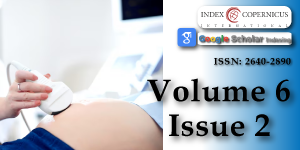Does change in cervical dilation after anesthesia impact latency after cerclage placement?
Main Article Content
Abstract
Background: Pregnant individuals with early cervical dilation have a high risk for preterm birth. The authors encountered cases where cervical dilation increased after anesthesia administration for a cerclage.
Objective: The primary objective was to assess if a change in cervical dilation after anesthesia administration for a cerclage was associated with a shorter latency to delivery.
Study design: This was a retrospective chart review of pregnancies from January 1, 2011, to December 31, 2021, who had a cerclage and delivered at our institution. Maternal demographics, obstetrical history, operative details, and delivery information were collected. Multi-fetal gestations, un-indicated cerclages, and abdominal cerclages were excluded. The primary outcome was the difference in cervical dilation between the office and the operating room after spinal anesthesia administration. A multivariable regression was performed.
Results: A total of 183 pregnancies were included. The mean gestational age at cerclage placement was 18 weeks (STDEV 3.6). Twenty-nine percent of patients (53/183) were more dilated in the operating room compared to the office The latency between cerclage and delivery was not different if there was a cervical change between these settings (p = 0.655). There was an increased risk for preterm delivery with dilation in the office (OR 1.01, CI 1.01 to 2.5), but not with dilation in the operating room (OR 1.4, CI 0.9 to 2.0).
Conclusion: Cervical dilation between the office and the operating room is different. Pregnancies with more dilation delivered at earlier gestations. However, a change in dilation between the office and the operating room was not associated with a shorter latency.
Article Details
Copyright (c) 202 Lende MN, et al.

This work is licensed under a Creative Commons Attribution 4.0 International License.
American College of Obstetricians and Gynecologists' Committee on Practice Bulletins—Obstetrics. Prediction and Prevention of Spontaneous Preterm Birth: ACOG Practice Bulletin, Number 234. Obstet Gynecol. 2021 Aug 1;138(2):e65-e90. doi: 10.1097/AOG.0000000000004479. PMID: 34293771.
American College of Obstetricians and Gynecologists’ Committee on Practice Bulletins—Obstetrics. Practice Bulletin No. 171: Management of Preterm Labor. Obstet Gynecol. 2016 Oct;128(4):e155-64. doi: 10.1097/AOG.0000000000001711. PMID: 27661654.
ACOG Practice Bulletin No.142: Cerclage for the management of cervical insufficiency. Obstet Gynecol. 2014 Feb;123(2 Pt 1):372-379. doi: 10.1097/01.AOG.0000443276.68274.cc. PMID: 24451674.
Ehsanipoor RM, Seligman NS, Saccone G, Szymanski LM, Wissinger C, Werner EF, Berghella V. Physical Examination-Indicated Cerclage: A Systematic Review and Meta-analysis. Obstet Gynecol. 2015 Jul;126(1):125-35. doi: 10.1097/AOG.0000000000000850. PMID: 26241265.
Conde-Agudelo A, Romero R, Da Fonseca E, O'Brien JM, Cetingoz E, Creasy GW, Hassan SS, Erez O, Pacora P, Nicolaides KH. Vaginal progesterone is as effective as cervical cerclage to prevent preterm birth in women with a singleton gestation, previous spontaneous preterm birth, and a short cervix: updated indirect comparison meta-analysis. Am J Obstet Gynecol. 2018 Jul;219(1):10-25. doi: 10.1016/j.ajog.2018.03.028. Epub 2018 Apr 7. PMID: 29630885; PMCID: PMC6449041.
Sanchez-Ramos L. Vaginal progesterone is an alternative to cervical cerclage in women with a short cervix and a history of preterm birth. Am J Obstet Gynecol. 2018 Jul;219(1):5-9. doi: 10.1016/j.ajog.2018.05.010. PMID: 29941278.
Leveno KJ, Cox K, Roark ML. Cervical dilatation and prematurity revisited. Obstet Gynecol. 1986 Sep;68(3):434-5. doi: 10.1097/00006250-198609000-00031. PMID: 3737067.
Miller ES, Grobman WA, Fonseca L, Robinson BK. Indomethacin and antibiotics in examination-indicated cerclage: a randomized controlled trial. Obstet Gynecol. 2014 Jun;123(6):1311-1316. doi: 10.1097/AOG.0000000000000228. PMID: 24807330.
How HY, Khoury JC, Sibai BM. Cervical dilatation on presentation for preterm labor and subsequent preterm birth. Am J Perinatol. 2009 Jan;26(1):1-6. doi: 10.1055/s-0028-1090586. Epub 2008 Nov 19. PMID: 19021099.
Phelps JY, Higby K, Smyth MH, Ward JA, Arredondo F, Mayer AR. Accuracy and intraobserver variability of simulated cervical dilatation measurements. Am J Obstet Gynecol. 1995 Sep;173(3 Pt 1):942-5. doi: 10.1016/0002-9378(95)90371-2. PMID: 7573274.
Buchmann EJ, Libhaber E. Accuracy of cervical assessment in the active phase of labour. BJOG. 2007 Jul;114(7):833-7. doi: 10.1111/j.1471-0528.2007.01386.x. PMID: 17567418.

